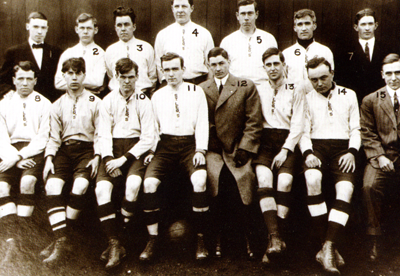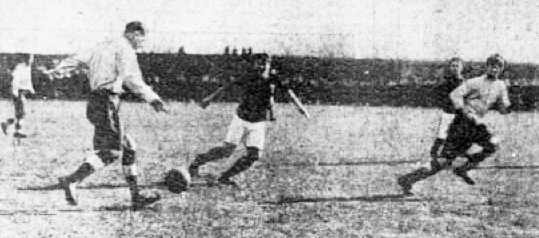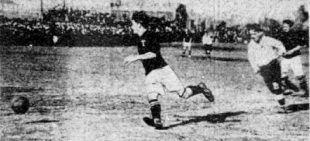When Tacony FC traveled to St. Louis in December of 1911 in one of the first tours pitting the largely immigrant-based East Coast teams against the largely native-born teams from the West, they had lost only three games in two years. The confidence they felt on departure proved to be premature and they returned to Philadelphia with a 4–4 draw against St. Leos in the “soccer championship of America” on Christmas Eve and lost to Innisfails on Christmas day, 3–1.
Many factors—fatigue from the long train journey to St. Louis, playing on the road, the back-to-back schedule—contributed to Tacony’s disappointing performance. But the prime reason was surely the fact nearly half of the players that Tacony took with them on the brief tour were not actually on the team’s regular roster. Tacony was a “professional” team—it’s players shared in gate receipts—but the players did not make their living from playing soccer and five of its regular starters could not get permission to leave work to make the trip.
Tacony would soon have an opportunity to gain their revenge, however. Shortly after they returned to Philadelphia, it was announced that St. Leos would be embarking on an East Coast tour in March of 1912.
 “Tacony seems to have struck the toboggan”
“Tacony seems to have struck the toboggan”
The Christmas holiday had allowed Tacony to make the trip to St. Louis. Christmas and New Years had long been occasions in Philadelphia soccer for exhibition games and, as two-time champions of the city’s Pennsylvania League, Tacony were naturally an in-demand draw. After arriving back in Philadelphia on Dec. 27, Tacony were scheduled to play Philadelphia Celtic on Dec. 30. What should have been an opportunity to erase the memory of the loss to Innisfails turned into more cause for disappointment.
Playing at Fairhill Ballpark at Third and Lehigh, Tacony conceded ten minutes after the kickoff. The Inquirer reported on Dec. 31 that Celtic “adopted the kick and rush style of game, and Tacony was kept on the jump,” smart enough tactics when meeting a team that was playing its third game in a week that also included two days of continuous rail travel. The Inquirer reported that Tacony nevertheless played the better game and “was valued for four or five goals.” But the equalizer would not come; Tacony captain Hector McDonald even missed a penalty kick. It was Tacony’s first loss in league play after eight straight wins.
Two days later, Tacony faced league rivals Philadelphia Hibernian in a New Years Day exhibition match. In front of “the largest crowd of the season,” Hibernian, whose lineup included future Hall of Famer Tommy Swords, beat Tacony at their own game, dropping their usual kick and rush tactics in favor of a combination game. “The front liners of the Hibernians showed in marked contrast to their opponents, ” described the Inquirer match report on January 2, 1912, “who seemed unable to get their passing machinery into motion.” Twenty minutes into the second half, the Hib’s Dawson “made no mistake” to record the only goal of the match. “This score was loudly applauded by the followers of the Hibernians, who have not had the opportunity of rooting for their pets in scoring a victory over the Pennsylvania League Champions, who have not had their colors lowered by the Irishmen for the last three years.”
With the loss in St. Louis and two losses in Philadelphia, Tacony had equaled in one week the total number of losses they had experienced in the previous two years. The Inquirer wrote on January 7, “Tacony seems to have struck the toboggan…Another slip on the part of Manager Campbell’s team will prove tough sledding for them to repeat for the third year in succession in the professional circuit.”
The next day the Inquirer reported that St. Leos would be traveling East in March. Tacony would be their first opponent.
Getting back on track
Bad weather caused the postponement of league play until Jan. 20 when Tacony bounced back with a 4–2 win over Gloucester Hibernian at Tacony Ballpark at State Road and Unruh Street. The Inquirer reported on Jan. 21, “the League champions were about as the score indicates, two goals better than their opponents.” Tacony was still in first place in the league with 18 points from 9 wins, two points over Philadelphia Victor and four points above Philadelphia Hibernian.
Tacony soon added to their roster, acquiring two players from the West Husdons of Harrison, New Jersey, one of whom was future Hall of Famer Robert Millar. Millar came to the US after playing for St. Mirren in Scotland. He would go on to have a long career in the US that would later include winning the first National Challenge Cup with Brooklyn Field Club, time with Bethlehem Steel and Philadelphia Hibernian, and coaching the US national team to the semifinals of the 1930 World Cup.
The transfer of the two West Hudson players to Tacony had occurred over the objections of Philadelphia Hibernian, which was understandable considering the two teams were due to face one another in only a few days time. The objections became more understandable when, in what the Inquirer referred to as “one of the prettiest plays imaginable,” Millar back-heeled a pass to McDonald to put Tacony up 1–0 only six minutes into the match. Ten minutes from time, Swords equalized for Hibs after receiving “a corking centre from the right wing” to keep their championship hopes alive.
Tacony next defeated Wissinoming 3–0 in league play on Feb. 17, then topped Gloucester Hibernians 4–1 on Feb. 24 in an exhibition game. But, Philadelphia Hibernian, having played one more game than Tacony, moved into first place in the Pennsylvania League for the first time in the season with a two point lead.
St Leos arrives in the East
St Leo’s arrived by train in Washington DC on March 14, resting overnight there before arriving in Philadelphia the next day. They had a tough schedule ahead of them. Beginning with a match against Tacony on Saturday, March 16, they would play West Hudsons in Newark on Sunday. After a few days of rest and travel, they would play Howard & Bullough, the current holders of the American Cup and title of “champions of the East” at New York’s American League Park on Wednesday, March 20. On Saturday, March 23, St. Leos would play Fall River Rovers before finishing their tour against the All-Nationals, a picked team of players from the National Association Football League (NAFBL), which was made up of teams from Northern New Jersey/New York City, on Sunday, March 24.
St. Leos arrived as the “champions of the West” after finishing ahead of Innisfails for their fifth consecutive St. Louis League title and then defeating Amateur League champions St. Marks on March 11 in the city’s Murray Cup final to claim the city championship.
Tacony falls short
With Tacony “bombarding their opponents goal right from the start,” the opening minutes of the match were dominated by the home team. Then, 16 minutes into the match, St. Leos scored on a counterattack. The goal began when the St. Leos’ keeper “fisted a hot shot” from the Tacony captain, Hector McDonald. The ball fell to St. Leos center halfback Peterson, “who in turn whipped the sphere” to outside right Donohue. Donohue “took the ball nearly half the length of the field by some remarkable footwork in which he practically beat the whole of the homesters’ backs.” Following up the play was inside right McCormack, who scored with “a superb shot…a low grounder.” The Inquirer reported on March 17, “this piece of splendid play on the part of the St. Leos was loudly applauded by the 3000 odd spectators that lined the field.”
While Tacony continued to dominate the run of play, generating chance after chance, they simply could not finish those chances. Then, just before the half, St. Leos again threatened with a counter when inside right and team captain “Bull” Brannigan received the ball “and with a clear field before him started one of his sensational runs.” Tacony right fullback Small was able to catch up to Brannigan but he couldn’t over take him. “Brannigan’s speed was too much for Small, who deliberately tripped Brannigan when he was completely beaten,” the Inquirer reported. “This act on the part of Small brought forth many uncomplimentary remarks from the crowd.”
St. Leos made it 2–0 five minutes into the second half off of a goal from Brannigan, his 24th goal of the season.
“Tacony soon realized they were in for a beating unless they began to show some of their true form,” reported the Inquirer. They quickly got a goal back when center halfback Clark headed in a cross from outside right Plant. Despite several more chances, Tacony couldn’t find the back of the net and the match ended in a 2–1 victory for the St. Louis team.
The Inquirer praised St. Leos as “one of the best balanced teams in the country,” giving particular credit to their goalkeeper as “the best defender on the field.” The match report continued, “Their defense is not much above the ordinary, but they have a rattling fast front line that is dangerous every time it gets the ball.”
Still, for all of the praise for St. Leos, the Inquirer concluded that “it is the consensus of opinion that the better team lost, for Tacony should have tallied more than one count with the numerous opportunities that came their way.” The report continued,
Time and again the front liners would work the ball down to their opponents’ citadel, but the final shot generally went wrong, the shooter booting the ball high over the bar or else wide of the mark. There is no denying the fact that the Pennsylvania League champions have never before this season given such a crude display in front of goal.
In another article on March 18, the Inquirer concluded that Tacony “once more proved that a team which is not in training cannot expect, no matter how strong they have shown heretofore, to beat a team that has been practicing right along.” The article continued, “There is some excuse on the part of Tacony in losing the game, as they had not played for three weeks prior to last Saturday, but even at that the Pennsylvania champions should have defeated the Westerners with the opportunities that McDonald and company had in the first period.”
St. Leos fortunes decline, Tacony’s rise
The next day, St. Leos lost in front of 3,000 spectators to West Hudsons, the eventual champions of the NAFBL and the 1912 American Cup, 3–2 at the West Hudson Oval in Harrison, New Jersey. Three days later, St. Leos was humiliated by American Cup holders Howard & Bullough 7–1 at American League Park in New York. The Inquirer reported on March 21,
The two elevens met in an alleged attempt to settle the soccer supremacy of the United States, but if the Westerners have not been in the habit of meeting very much weaker sides than their opponents of today, they will have to show greatly improved form if they mean to clash with the crack teams of the East…For the St. Leos the result was worse than defeat, it was an annihilation and their experience of today will probably teach them that to win a soccer game it is necessary to do more than cut a lot of fancy and needless capers in midfield.
St. Leos managed a 1–1 draw against Fall River Rovers. The Pawtucket Evening Times reported on March 25 that the St. Louis team should have won as they outplayed the Fall River team, “who were really an all-star team of Rover, Oak and Fore River players,” and whose single tally came from a St. Leos own-goal. If, as the Evening Times report suggests, the St. Leos team was “seriously bothered” by the heavy field conditions in their match against the Rovers, the conditions the next day against the NAFBL all-star team the All-Nationals at a muddy Olympic Park in Patterson were even worse. The Evening Times reported that the game “took place in a snowstorm which later turned into a torrent of rain” and that the “western cracks seemed lost.” In contrast, the All-Nationals, the Inquirer reported on March 25, “proved themselves to be good ‘mudhorses.'” St. Leos lost the game 4–2 to return home with a 1–3–1 record.
The tour had been a disappointment. Not only had the team performed poorly, poor crowds at some of the games—the Inquirer described the turnout for the midweek game against Howard & Bullough as “one of the smallest crowds that have ever witnessed a game of this class in this district” and poor weather affected the turnout for the Fall River and All-Nationals games—meant that the tour lost money.
The defeat to St. Leos behind them, Tacony’s attention returned to winning their third consecutive Pennsylvania League title. They were aided in this when Philadelphia Thistle forfeited on March 30 after they traveled to Tacony shorthanded. On April 6, Tacony defeated Tennyson 3–1 in a rough match at Washington Park at 26th and Allegheny in which one Tacony player was cautioned, and another ejected, for striking Tennyson players on two separate occasions.
Tacony secured the Pennsylvania League championship on April 13 when they defeated Trenton Caledonians 1–0 in Trenton. They finished out the season on April 20 with a 2–0 win over Victor at Tacony Ballpark.





Oh I remember those days
Grantland Rice would approve! Well done Ed.